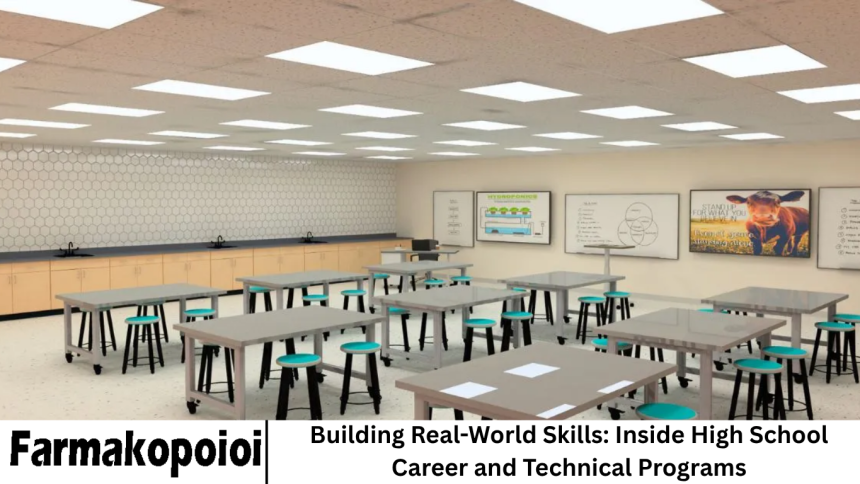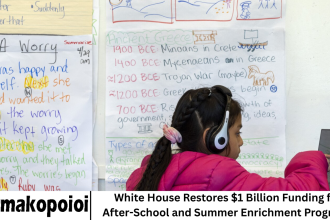In today’s fast-changing economy, the traditional high school path that funnels students directly toward four-year universities is no longer the only — or even the most practical — option for many. Across the United States, a quiet transformation is taking place in education: the rise of Career.
- What Are Career and Technical Education (CTE) Programs?
- The Historical Shift Toward Modern CTE
- Why CTE Programs Matter Now More Than Ever
- Addressing the Skills Gap
- Boosting Student Engagement and Graduation Rates
- Providing Equitable Access to Opportunity
- Preparing for the Future of Work
- Inside the Classroom: What Students Learn in CTE
- CTE Success Stories: Real Impact Across America
- Challenges Facing CTE Programs
- The Economic and Social Benefits of CTE
- The Future of Career and Technical Education
- Integration with Emerging Technologies
- Greater Collaboration Between Education and Industry
- Focus on Micro-Credentials and Lifelong Learning
- Expansion of Equity Initiatives
- How Parents and Students Can Get Involved
- Frequently Asked Question
- Conclusion
And Technical Education (CTE) programs. These programs combine academic instruction with hands-on, career-focused training designed to prepare students for high-demand jobs, college pathways, and lifelong success.
CTE programs are redefining what it means to be “college and career ready.” By giving high schoolers opportunities to explore industries such as healthcare, information technology, manufacturing, and culinary arts, these programs equip students with not just knowledge.
More Read: China’s Zhipu AI predicts that achieving full artificial superintelligence is unlikely before 2030.
What Are Career and Technical Education (CTE) Programs?
Career and Technical Education refers to courses and pathways that blend academic instruction with technical and vocational training. Unlike traditional electives, CTE programs are structured to give students practical experience and credentials that can directly lead to employment or postsecondary education.
CTE programs exist in all 50 states and are often organized into career clusters, such as:
- Health Science
- Information Technology
- Business Management
- Agriculture, Food, and Natural Resources
- Manufacturing
- Arts, A/V Technology, and Communications
- Science, Technology, Engineering, and Mathematics (STEM)
Each cluster contains specialized pathways — for example, under Health Science, students might study medical assisting, dental technology, or nursing fundamentals.
Many CTE programs partner with community colleges, trade schools, and local businesses, offering students internships, apprenticeships, and dual-enrollment opportunities where they can earn college credit or industry-recognized certifications while still in high school.
The Historical Shift Toward Modern CTE
Decades ago, vocational education had a reputation for tracking students — often unfairly — away from college and toward blue-collar jobs. It was seen as a lesser alternative to academic learning. However, that outdated image is rapidly changing.
Today’s Career and Technical Education 2.0 is about integration, not separation. Students enrolled in CTE are just as likely to attend college as their peers in traditional programs, and they often do so with clearer goals and practical skills.
This shift began in the early 2000s when education policy started emphasizing “college and career readiness.” The Carl D. Perkins Career and Technical Education Act, reauthorized in 2018 as Perkins V, gave states more flexibility to modernize CTE programs.
Aligning them with workforce needs and encouraging collaboration between schools and industries.
As a result, modern CTE programs are now built around three core principles:
- Academic Rigor: Courses align with state academic standards.
- Technical Skills: Students gain job-ready, industry-specific competencies.
- Work-Based Learning: Real-world experiences, from internships to apprenticeships, are central to the curriculum.
Why CTE Programs Matter Now More Than Ever
Addressing the Skills Gap
The U.S. faces a persistent skills gap — millions of jobs remain unfilled because employers cannot find workers with the right training. According to the National Skills Coalition, over 50% of all jobs require skills training beyond high school but not necessarily a bachelor’s degree.
CTE programs directly target this gap by preparing students early for careers in high-demand sectors.
Boosting Student Engagement and Graduation Rates
CTE students are more likely to stay in school and graduate. Studies by the Association for Career and Technical Education show that CTE concentrators (students who complete multiple courses in a single career pathway) have a graduation rate of over 95%, significantly higher than the national average.
Hands-on, relevant learning keeps students motivated and connected to their future goals.
Providing Equitable Access to Opportunity
CTE programs serve a diverse student population, including those from underserved and rural communities. By offering pathways into stable, well-paying careers, these programs promote economic mobility and help close the opportunity gap.
Preparing for the Future of Work
Automation and AI are transforming industries. Many jobs of the future will demand a mix of technical expertise and human creativity. CTE programs emphasize problem-solving, teamwork, and adaptability — all critical skills for navigating a tech-driven workforce.
Inside the Classroom: What Students Learn in CTE
Career and Technical Education is not a one-size-fits-all approach. It’s a dynamic ecosystem that integrates theory, practice, and professional exposure.
Hands-On Training
CTE classrooms often look more like workplaces than traditional schools. Students might be welding, programming robots, or designing marketing campaigns. In culinary programs, they prepare meals in professional kitchens; in automotive technology, they repair real vehicles.
Industry Partnerships
Schools collaborate with local employers to ensure curriculum relevance. These partnerships often result in internships, mentoring, and even job placements. For example, a high school partnering with a local hospital may allow students to shadow nurses or medical technicians.
Dual Enrollment and Certification
Many programs let students earn college credits or industry credentials before graduation. Certifications such as CompTIA for IT, Certified Nursing Assistant (CNA), or Adobe Creative Suite credentials give graduates a competitive edge.
Soft Skills Development
Beyond technical know-how, students learn communication, leadership, and time management — essential qualities that employers consistently value.
CTE Success Stories: Real Impact Across America
Tennessee’s Pathways to Prosperity
Tennessee’s CTE model integrates high school, community college, and industry training into cohesive career pathways. Students can graduate with both a diploma and a postsecondary credential, allowing them to step directly into skilled jobs or continue higher education with less debt.
California’s Linked Learning Approach
California’s “Linked Learning” initiative combines rigorous academics with career-based learning. High schoolers explore fields such as health sciences or digital media through project-based learning, internships, and mentorship. Early data shows improved graduation and college enrollment rates.
New York City’s P-TECH Model
The Pathways in Technology Early College High Schools (P-TECH) program allows students to earn both a high school diploma and an associate degree within six years, all while gaining work experience at partner companies like IBM. This model has become a national blueprint for career-integrated education.
Challenges Facing CTE Programs
While the benefits of CTE are clear, these programs also face significant hurdles:
Funding Inequities
CTE programs are expensive to operate — equipment, facilities, and certified instructors all cost more than standard classrooms. Many schools struggle with insufficient funding, despite federal support through Perkins V.
Outdated Perceptions
Despite modernization, some parents and educators still see CTE as a “second-tier” option. Overcoming this stigma requires ongoing public awareness about how CTE aligns with high-demand, high-wage careers.
Teacher Shortages
Finding qualified instructors with both teaching credentials and real-world industry experience can be difficult, especially in technical fields like IT, engineering, and healthcare.
Keeping Up with Technology
Industries evolve rapidly, and curricula can quickly become outdated. Maintaining partnerships with local businesses helps ensure that instruction remains aligned with current workforce trends.
The Economic and Social Benefits of CTE
The impact of CTE extends beyond individual success — it strengthens communities and economies. Students who complete CTE programs are more likely to:
- Find employment faster after graduation.
- Earn higher wages earlier in their careers.
- Contribute to local industries experiencing labor shortages.
Moreover, CTE participation helps reduce youth unemployment and underemployment. By connecting students directly to real-world opportunities, schools build pipelines that keep talent in their regions, supporting local growth and innovation.
The Future of Career and Technical Education
Looking ahead, CTE is expected to expand and evolve in several key ways:
Integration with Emerging Technologies
Programs are increasingly incorporating fields like cybersecurity, renewable energy, and artificial intelligence, preparing students for the industries of tomorrow.
Greater Collaboration Between Education and Industry
Future CTE will rely heavily on partnerships with businesses to design curricula, provide mentorship, and facilitate apprenticeships that mirror real work experiences.
Focus on Micro-Credentials and Lifelong Learning
Students will have opportunities to earn stackable credentials, allowing them to build their qualifications over time as they transition from high school to higher education or new career stages.
Expansion of Equity Initiatives
States and districts are working to ensure that CTE is accessible to all students, including women in STEM, students with disabilities, and those from low-income backgrounds.
How Parents and Students Can Get Involved
Parents play a crucial role in supporting students exploring CTE pathways. Here’s how they can engage:
- Research Local Offerings: Many high schools and districts provide brochures or websites outlining available programs.
- Attend Information Sessions: CTE open houses often feature demonstrations, student projects, and talks from industry partners.
- Encourage Exploration: Students can try introductory CTE courses to identify interests before committing to a specific pathway.
- Support Dual Enrollment: If available, dual-credit programs help reduce future college costs and accelerate credential attainment.
Frequently Asked Question
What is the main goal of Career and Technical Education (CTE)?
The primary goal of CTE is to prepare students for both college and career success by combining academic knowledge with technical, hands-on experience in various fields like healthcare, technology, and business.
Do CTE students still go to college?
Yes. Many CTE students pursue college degrees, often with a clearer sense of purpose. CTE provides practical foundations that complement higher education and can reduce the time and cost of obtaining a degree.
How is CTE different from traditional high school electives?
While electives may focus on general interests, CTE programs offer structured career pathways leading to certifications, internships, and real-world experience tied directly to job markets.
Can students earn college credits through CTE programs?
Absolutely. Many CTE programs offer dual-enrollment options that allow students to earn college credits or industry certifications while still in high school.
Which industries offer the most CTE opportunities?
Some of the fastest-growing CTE fields include healthcare, information technology, advanced manufacturing, construction, renewable energy, and digital design.
Are CTE programs only for students not planning to attend college?
Not at all. CTE serves a wide range of students, including those aiming for college, trade schools, or direct entry into the workforce. It’s about expanding choices, not limiting them.
How can schools improve their CTE programs?
Schools can strengthen CTE by investing in updated technology, forming strong partnerships with local industries, providing teacher training, and promoting awareness to combat outdated stigmas.
Conclusion
Career and Technical Education is no longer a niche or fallback option — it’s a central part of America’s education and workforce strategy. By blending academic learning with real-world experience, CTE programs empower students to chart their own paths toward meaningful careers, financial independence, and lifelong learning.
As industries continue to evolve, the value of skilled, adaptable workers grows exponentially. CTE ensures that high school students are not just prepared for their next exam — they’re prepared for the world.






















